Michael A. Riegler
Kvasir-VQA-x1: A Multimodal Dataset for Medical Reasoning and Robust MedVQA in Gastrointestinal Endoscopy
Jun 11, 2025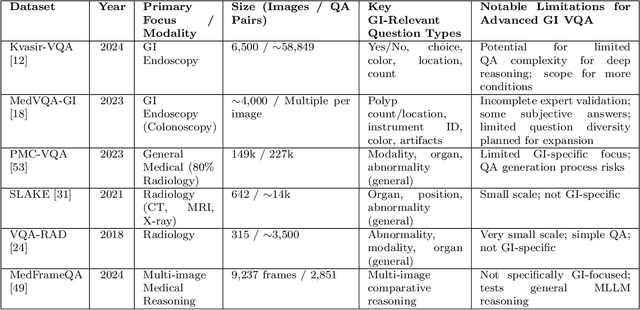
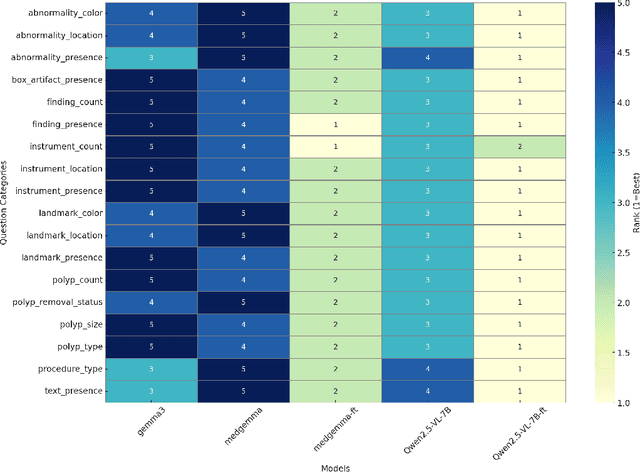
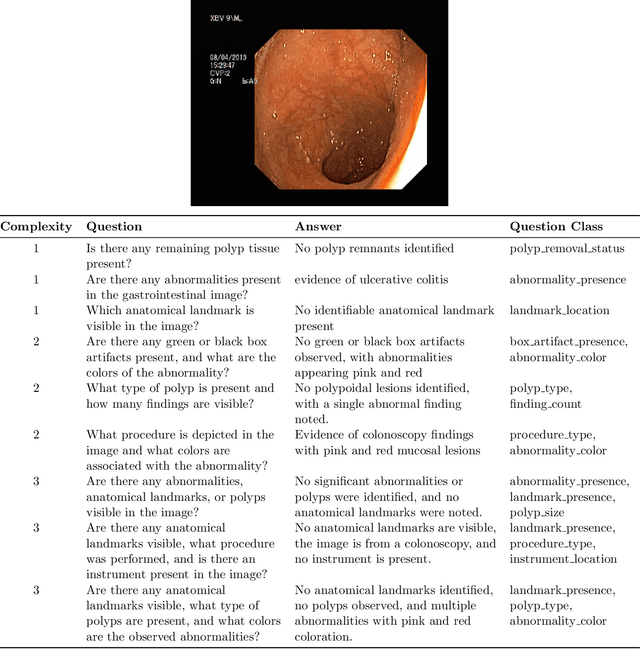
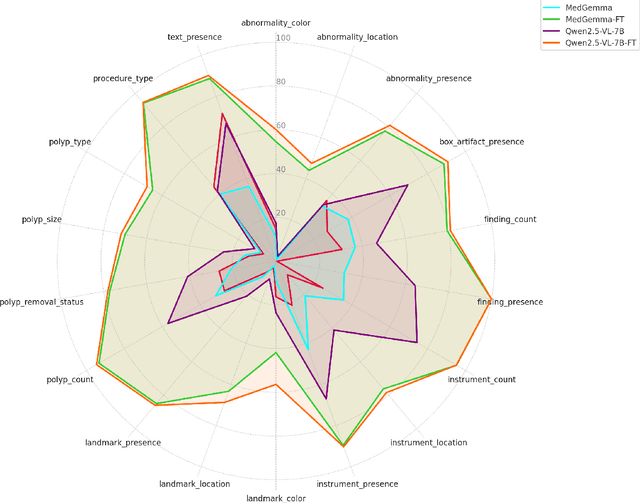
Abstract:Medical Visual Question Answering (MedVQA) is a promising field for developing clinical decision support systems, yet progress is often limited by the available datasets, which can lack clinical complexity and visual diversity. To address these gaps, we introduce Kvasir-VQA-x1, a new, large-scale dataset for gastrointestinal (GI) endoscopy. Our work significantly expands upon the original Kvasir-VQA by incorporating 159,549 new question-answer pairs that are designed to test deeper clinical reasoning. We developed a systematic method using large language models to generate these questions, which are stratified by complexity to better assess a model's inference capabilities. To ensure our dataset prepares models for real-world clinical scenarios, we have also introduced a variety of visual augmentations that mimic common imaging artifacts. The dataset is structured to support two main evaluation tracks: one for standard VQA performance and another to test model robustness against these visual perturbations. By providing a more challenging and clinically relevant benchmark, Kvasir-VQA-x1 aims to accelerate the development of more reliable and effective multimodal AI systems for use in clinical settings. The dataset is fully accessible and adheres to FAIR data principles, making it a valuable resource for the wider research community. Code and data: https://github.com/Simula/Kvasir-VQA-x1 and https://huggingface.co/datasets/SimulaMet/Kvasir-VQA-x1
SoccerChat: Integrating Multimodal Data for Enhanced Soccer Game Understanding
May 22, 2025Abstract:The integration of artificial intelligence in sports analytics has transformed soccer video understanding, enabling real-time, automated insights into complex game dynamics. Traditional approaches rely on isolated data streams, limiting their effectiveness in capturing the full context of a match. To address this, we introduce SoccerChat, a multimodal conversational AI framework that integrates visual and textual data for enhanced soccer video comprehension. Leveraging the extensive SoccerNet dataset, enriched with jersey color annotations and automatic speech recognition (ASR) transcripts, SoccerChat is fine-tuned on a structured video instruction dataset to facilitate accurate game understanding, event classification, and referee decision making. We benchmark SoccerChat on action classification and referee decision-making tasks, demonstrating its performance in general soccer event comprehension while maintaining competitive accuracy in referee decision making. Our findings highlight the importance of multimodal integration in advancing soccer analytics, paving the way for more interactive and explainable AI-driven sports analysis. https://github.com/simula/SoccerChat
Point, Detect, Count: Multi-Task Medical Image Understanding with Instruction-Tuned Vision-Language Models
May 22, 2025Abstract:We investigate fine-tuning Vision-Language Models (VLMs) for multi-task medical image understanding, focusing on detection, localization, and counting of findings in medical images. Our objective is to evaluate whether instruction-tuned VLMs can simultaneously improve these tasks, with the goal of enhancing diagnostic accuracy and efficiency. Using MedMultiPoints, a multimodal dataset with annotations from endoscopy (polyps and instruments) and microscopy (sperm cells), we reformulate each task into instruction-based prompts suitable for vision-language reasoning. We fine-tune Qwen2.5-VL-7B-Instruct using Low-Rank Adaptation (LoRA) across multiple task combinations. Results show that multi-task training improves robustness and accuracy. For example, it reduces the Count Mean Absolute Error (MAE) and increases Matching Accuracy in the Counting + Pointing task. However, trade-offs emerge, such as more zero-case point predictions, indicating reduced reliability in edge cases despite overall performance gains. Our study highlights the potential of adapting general-purpose VLMs to specialized medical tasks via prompt-driven fine-tuning. This approach mirrors clinical workflows, where radiologists simultaneously localize, count, and describe findings - demonstrating how VLMs can learn composite diagnostic reasoning patterns. The model produces interpretable, structured outputs, offering a promising step toward explainable and versatile medical AI. Code, model weights, and scripts will be released for reproducibility at https://github.com/simula/PointDetectCount.
Energy-Conscious LLM Decoding: Impact of Text Generation Strategies on GPU Energy Consumption
Feb 17, 2025



Abstract:Decoding strategies significantly influence the quality and diversity of the generated texts in large language models (LLMs), yet their impact on computational resource consumption, particularly GPU energy usage, is insufficiently studied. This paper investigates the relationship between text generation decoding methods and energy efficiency, focusing on the trade-off between generation quality and GPU energy consumption across diverse tasks and decoding configurations. By benchmarking multiple strategies across different text generation tasks, such as Translation, Code Summarization, and Math Problem Solving, we reveal how selecting appropriate decoding techniques with their tuned hyperparameters affects text quality and has measurable implications for resource utilization, emphasizing the need for balanced optimization. To the best of our knowledge, this study is among the first to explore decoding strategies in LLMs through the lens of energy consumption, offering actionable insights for designing resource-aware applications that maintain high-quality text generation.
Principal Components for Neural Network Initialization
Jan 31, 2025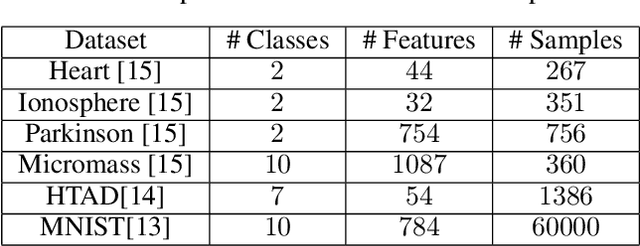



Abstract:Principal Component Analysis (PCA) is a commonly used tool for dimension reduction and denoising. Therefore, it is also widely used on the data prior to training a neural network. However, this approach can complicate the explanation of explainable AI (XAI) methods for the decision of the model. In this work, we analyze the potential issues with this approach and propose Principal Components-based Initialization (PCsInit), a strategy to incorporate PCA into the first layer of a neural network via initialization of the first layer in the network with the principal components, and its two variants PCsInit-Act and PCsInit-Sub. Explanations using these strategies are as direct and straightforward as for neural networks and are simpler than using PCA prior to training a neural network on the principal components. Moreover, as will be illustrated in the experiments, such training strategies can also allow further improvement of training via backpropagation.
DPERC: Direct Parameter Estimation for Mixed Data
Jan 17, 2025Abstract:The covariance matrix is a foundation in numerous statistical and machine-learning applications such as Principle Component Analysis, Correlation Heatmap, etc. However, missing values within datasets present a formidable obstacle to accurately estimating this matrix. While imputation methods offer one avenue for addressing this challenge, they often entail a trade-off between computational efficiency and estimation accuracy. Consequently, attention has shifted towards direct parameter estimation, given its precision and reduced computational burden. In this paper, we propose Direct Parameter Estimation for Randomly Missing Data with Categorical Features (DPERC), an efficient approach for direct parameter estimation tailored to mixed data that contains missing values within continuous features. Our method is motivated by leveraging information from categorical features, which can significantly enhance covariance matrix estimation for continuous features. Our approach effectively harnesses the information embedded within mixed data structures. Through comprehensive evaluations of diverse datasets, we demonstrate the competitive performance of DPERC compared to various contemporary techniques. In addition, we also show by experiments that DPERC is a valuable tool for visualizing the correlation heatmap.
Missing data imputation for noisy time-series data and applications in healthcare
Dec 15, 2024


Abstract:Healthcare time series data is vital for monitoring patient activity but often contains noise and missing values due to various reasons such as sensor errors or data interruptions. Imputation, i.e., filling in the missing values, is a common way to deal with this issue. In this study, we compare imputation methods, including Multiple Imputation with Random Forest (MICE-RF) and advanced deep learning approaches (SAITS, BRITS, Transformer) for noisy, missing time series data in terms of MAE, F1-score, AUC, and MCC, across missing data rates (10 % - 80 %). Our results show that MICE-RF can effectively impute missing data compared to deep learning methods and the improvement in classification of data imputed indicates that imputation can have denoising effects. Therefore, using an imputation algorithm on time series with missing data can, at the same time, offer denoising effects.
Embryo 2.0: Merging Synthetic and Real Data for Advanced AI Predictions
Dec 02, 2024Abstract:Accurate embryo morphology assessment is essential in assisted reproductive technology for selecting the most viable embryo. Artificial intelligence has the potential to enhance this process. However, the limited availability of embryo data presents challenges for training deep learning models. To address this, we trained two generative models using two datasets, one we created and made publicly available, and one existing public dataset, to generate synthetic embryo images at various cell stages, including 2-cell, 4-cell, 8-cell, morula, and blastocyst. These were combined with real images to train classification models for embryo cell stage prediction. Our results demonstrate that incorporating synthetic images alongside real data improved classification performance, with the model achieving 97% accuracy compared to 95% when trained solely on real data. Notably, even when trained exclusively on synthetic data and tested on real data, the model achieved a high accuracy of 94%. Furthermore, combining synthetic data from both generative models yielded better classification results than using data from a single generative model. Four embryologists evaluated the fidelity of the synthetic images through a Turing test, during which they annotated inaccuracies and offered feedback. The analysis showed the diffusion model outperformed the generative adversarial network model, deceiving embryologists 66.6% versus 25.3% and achieving lower Frechet inception distance scores.
Comparative Analysis of Audio Feature Extraction for Real-Time Talking Portrait Synthesis
Nov 20, 2024



Abstract:This paper examines the integration of real-time talking-head generation for interviewer training, focusing on overcoming challenges in Audio Feature Extraction (AFE), which often introduces latency and limits responsiveness in real-time applications. To address these issues, we propose and implement a fully integrated system that replaces conventional AFE models with Open AI's Whisper, leveraging its encoder to optimize processing and improve overall system efficiency. Our evaluation of two open-source real-time models across three different datasets shows that Whisper not only accelerates processing but also improves specific aspects of rendering quality, resulting in more realistic and responsive talking-head interactions. These advancements make the system a more effective tool for immersive, interactive training applications, expanding the potential of AI-driven avatars in interviewer training.
Enhancing Structured-Data Retrieval with GraphRAG: Soccer Data Case Study
Sep 26, 2024



Abstract:Extracting meaningful insights from large and complex datasets poses significant challenges, particularly in ensuring the accuracy and relevance of retrieved information. Traditional data retrieval methods such as sequential search and index-based retrieval often fail when handling intricate and interconnected data structures, resulting in incomplete or misleading outputs. To overcome these limitations, we introduce Structured-GraphRAG, a versatile framework designed to enhance information retrieval across structured datasets in natural language queries. Structured-GraphRAG utilizes multiple knowledge graphs, which represent data in a structured format and capture complex relationships between entities, enabling a more nuanced and comprehensive retrieval of information. This graph-based approach reduces the risk of errors in language model outputs by grounding responses in a structured format, thereby enhancing the reliability of results. We demonstrate the effectiveness of Structured-GraphRAG by comparing its performance with that of a recently published method using traditional retrieval-augmented generation. Our findings show that Structured-GraphRAG significantly improves query processing efficiency and reduces response times. While our case study focuses on soccer data, the framework's design is broadly applicable, offering a powerful tool for data analysis and enhancing language model applications across various structured domains.
 Add to Chrome
Add to Chrome Add to Firefox
Add to Firefox Add to Edge
Add to Edge